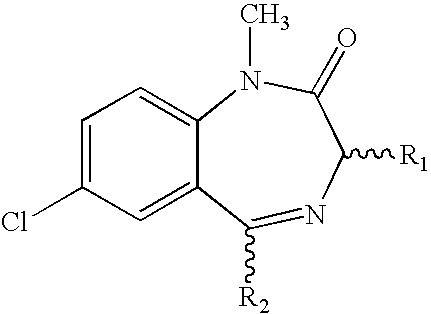Compositions and methods relating to novel compounds and targets thereof
a technology of novel compounds and compounds, applied in the field of compositions and methods relating to novel compounds and targets thereof, can solve the problems of limiting efficacy, affecting the efficacy serious drawbacks of existing cytotoxic chemotherapeutic agents, so as to increase the exchange rate of atp, reduce the level of profilin 1, and increase the rate of actin filament turnover
- Summary
- Abstract
- Description
- Claims
- Application Information
AI Technical Summary
Benefits of technology
Problems solved by technology
Method used
Image
Examples
example 1
Preparation of Compounds
[0276] The benzodiazepine compounds are prepared using either solid-phase or soluble-phase combinatorial synthetic methods as well as on an individual basis from well-established techniques. See, for example, Boojamra, C. G. et al. (1996); Bunin, B. A., et al. (1994); Stevens, S. Y. et al., (1996); Gordon, E. M., et al., (1994); and U.S. Pat. Nos. 4,110,337 and 4,076,823, which are all incorporated by reference herein. For illustration, the following general methodologies are provided.
[0277] Preparation of 1,4-benzodiazepine-2-one Compounds
[0278] Improved solid-phase synthetic methods for the preparation of a variety of 1,4-benzodiazepine-2-one derivatives with very high overall yields have been reported in the literature. (See e.g., Bunin and Ellman, J. Am. Chem. Soc., 114:10997-10998 [1992]). Using these improved methods, the 1,4-benzodiazepine-2-ones is constructed on a solid support from three separate components: 2-aminobenzophenones, .alpha.-amino acids...
example 2
[0293] It should be recognized that many of the benzodiazepines of the present invention exist as optical isomers due to chirality wherein the stereocenter is introduced by the .alpha.-amino acid and its ester starting materials. The above-described general procedure preserves the chirality of the .alpha.-amino acid or ester starting materials. In many cases, such preservation of chirality is desirable. However, when the desired optical isomer of the .alpha.-amino acid or ester starting material is unavailable or expensive, a racemic mixture is produced which is separated into the corresponding optical isomers and the desired benzodiazepine enantiomer is isolated.
[0294] For example, in the case of the 2,5-dione compounds, Boojamra, supra, discloses that complete racemization is accomplished by preequilibrating the hydrochloride salt of the enantiomerically pure .alpha.-amino ester starting material with 0.3 equivalents of i-Pr.sub.2EtN and the resin-bound aldehyde for 6 hou...
example 3
Reagents
[0296] Bz-423 is synthesized as described above. FK506 is obtained from Fujisawa (Osaka, Japan). N-benzoylcarbonyl-Val-Ala-Asp-fluoromethylketone (z-VAD) is obtained from Enzyme Systems (Livermore, Calif.). Dihydroethidium (DHE) and 3,3'-dihexyloxacarbocyanine iodide (DiOC.sub.6(3)) are obtained from Molecular Probes (Eugene, Oreg.). FAM-VAD-fink is obtained from Intergen (Purchase, N.J.). Manganese(III)meso-tetrakis(4-benzoic acid)porphyrin (MnTBAP) is purchased from Alexis Biochemicals (San Diego, Calif.). Benzodiazepines is synthesized as described (See, B. A. Bunin et al., Proc. Natl. Acad. Sci. U.S.A., 91:4708-4712 [1994]). Other reagents were obtained from Sigma (St. Louis, Mo.).
PUM
 Login to View More
Login to View More Abstract
Description
Claims
Application Information
 Login to View More
Login to View More - R&D
- Intellectual Property
- Life Sciences
- Materials
- Tech Scout
- Unparalleled Data Quality
- Higher Quality Content
- 60% Fewer Hallucinations
Browse by: Latest US Patents, China's latest patents, Technical Efficacy Thesaurus, Application Domain, Technology Topic, Popular Technical Reports.
© 2025 PatSnap. All rights reserved.Legal|Privacy policy|Modern Slavery Act Transparency Statement|Sitemap|About US| Contact US: help@patsnap.com



